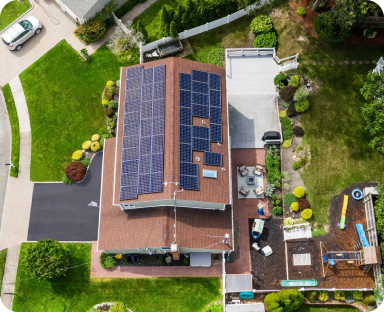Solar power has gained popularity in recent years, and it’s clear it’s not going anywhere. The financial and environmental benefits make solar energy profoundly advantageous for homes and businesses alike. If you’re new to using solar energy to power residential and commercial spaces, we’re breaking down the basics of solar energy — including the benefits, process, and cost of going solar — below.
Why Does Solar Energy Matter?
Unlike electricity, solar energy is infinitely renewable. Not only that, it’s infinitely renewable without harming the environment, unlike the use of fossil fuels. Since solar energy comes directly from the sun, there’s no drain on the earth’s finite resources, like oil. Solar energy is also a clean source of energy that doesn’t pollute the air or contribute to global warming.
Because solar energy is a win-win for both the environment and the user, making the switch to solar power is a game-changing choice for both residential and commercial spaces.
What Is Solar Energy?
Solar energy is energy derived from the sun’s rays. It’s an energy source that helps both plants and people grow, nourishing and regulating all life forms on Earth. Without it, our planet would not only be dark but dead.
Are There Different Types of Solar Energy?
There are a few different types of solar energy to understand before making the switch to solar power.
1. Photovoltaic Systems
The most common way to harness solar energy to power your home or business is with the use of a photovoltaic (PV) system. These systems consist of semiconductor materials that absorb sunlight and create a reaction that generates electricity. This technology is quickly evolving to improve efficiency. Today, thin film solar cells are able to use layers of semiconductor materials that are only a few micrometers thick. This makes it possible for solar cells to be used as roof shingles, roof tiles, building facades, skylight glazing, and more.
2. Solar Water-Heating Systems
These systems consist of a solar collector and a storage tank. Instead of using electricity to produce hot water, these systems use the sun. The most common type of collector is called a flat-plate collector. This is mounted on the roof and faces the sun, with tubes carrying water throughout. As the sun heats the collector, it heats the water flowing through. The storage tank then holds the hot water.
3. Solar Power Plants
This is most often used for industrial applications. Most power plants rely on non-renewable fossil fuels to heat water. The steam produced activates a large turbine that helps generate electricity, but this process emits harmful greenhouse gases.
Today, however, power plants can utilize solar energy through parabolic-trough systems, dish/engine systems, or power tower systems for clean, sustainable electricity generation.
4. Passive Solar Heating
A final, and definitely not new, way solar energy can be harnessed is through passive solar heating and daylighting. This involves designing a space in a way that naturally captures sunlight throughout the day and slowly releases it at night to continue to heat a space after the sun has gone down.
How Difficult Is It to Switch to Solar?
When working with a qualified professional, making the switch to solar power is simple. Installation will first require an engineering site visit to make sure your space is suitable for a system. Then, necessary permits and documentation must be secured, as well as ordering equipment. Next, the solar panels will be professionally installed, assessed, and connected.
How Much Does It Cost to Switch to Solar?
The cost of switching to a solar-powered energy system varies by location. In most cases, solar energy costs less than what you pay the public utility for electricity, especially when you look at the gains over time. Most residential users make back their investment in utility savings within four to seven years. Since SunPower solar panels are warrantied for 25 years, that’s an ROI of four or five times what you spent on the system.
Plus, there are tax credits for going solar. Under the Federal Tax Credit (ITC), 26% of your project costs, including installation, go toward a credit to offset your tax burden when you file with the IRS. New York State, New York City, and local utilities all have unique incentives available to help you go solar. When combined, these incentives can cover 50% or more of your total system cost.
Get a Free Solar Estimate Today!
There’s a reason solar energy systems are becoming more and more popular. Their environmental and financial benefits prove to be worthwhile. Curious if your home or business would be a good candidate for a solar power system? Contact us to start the conversation!
Stop overpaying for electric. Go solar with $0 down.

Stop overpaying for electric. Go solar with $0 down.
About the Author
EmPower Solar develops, engineers, installs, and services solar and battery systems for residential and commercial clients. Since 2003, EmPower Solar has empowered thousands of New York homeowners and businesses with 47 megawatts of distributed solar. Its vision is to create a new energy paradigm powered by clean, renewable energy for a more prosperous, healthy, and civil world. The company culture is defined by the EmPowering Way, which results in consistent 5-star customer service reviews. For more information visit empower-solar.com.